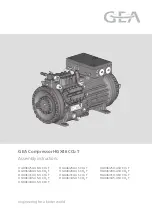
16
English
WARNING:
Risk of unsafe operation. Unit cycles automati-
cally when power is on. When performing maintenance, you may
be exposed to voltage sources, compressed air, or moving parts.
Personal injuries can occur. Before performing any maintenance or
repair, disconnect power source from the compressor and bleed off
all air pressure.
To ensure efficient operation and longer life of the air compressor
outfit, a routine maintenance schedule should be prepared and fol-
lowed. The following routine maintenance schedule is geared to an
outfit in a normal working environment operating on a daily basis.
If necessary, the schedule should be modified to suit the condi-
tions under which your compressor is used. The modifications will
depend upon the hours of operation and the working environment.
Compressor outfits in an extremely dirty and/or hostile environment
will require a greater frequency of all maintenance checks.
NOTE: See Operation section for the location of controls.
Checking Safety Valve (Fig. 1)
WARNING:
Hot surfaces. Risk of burn. Tubes, pump head, and
surrounding parts are very hot, do not touch (see the Hot Surfaces
identified in Fig. 2). Allow compressor to cool prior to servicing.
WARNING:
Risk of bursting. If the safety valve does not work
properly, over-pressurization may occur, causing air tank rupture or
an explosion.
WARNING:
Risk from flying objects. Always wear certified safety
equipment: ANSI Z87.1 eye protection (CAN/CSA Z94.3) with side
shields.
Before starting compressor, pull the ring on the safety valve to
make sure that the safety valve operates freely. If the valve is stuck
or does not operate smoothly, it must be replaced with the same
type of valve.
Checking Air Filter (Fig. 1)
WARNING:
Hot surfaces. Risk of burn. Tubes, pump head, and
surrounding parts are very hot, do not touch (see the Hot Surfaces
identified in Fig. 2). Allow compressor to cool prior to servicing.
A dirty air filter will not allow the compressor to operate at full
capacity. Keep the air filter clean at all times.
1. Ensure Auto/Off switch (B) is in the OFF Position.
2. Allow unit to cool.
S
T
R
3. Remove the 2 wing nuts (R).
4. Remove the outer metal covers
(S).
5. Check the filter elements (T) if
they are dirty or filled with paint,
replace them.
6. Place the outer metal covers
back over the filter elements.
7. Secure with the wing nuts.
CAUTION:
Risk of unsafe operation. Do not operate without air
filter.
Draining Air Tank (Fig. 3)
WARNING:
Risk of unsafe operation. Air tanks contain high
pressure air. Keep face and other body parts away from outlet of
drain. Use eye protection [ANSI Z87.1 (CAN/CSA Z94.3)] when
draining as debris can be kicked up into face.
WARNING:
Risk from noise. Use ear protection (ANSI S12.6
(S3.19) as air flow noise is loud when draining.
NOTE:
All compressed air systems generate condensation that accu-
mulates in any drain point (e.g., tanks, filter, aftercoolers, dryers). This













































